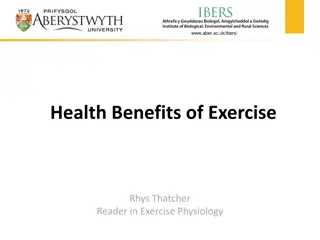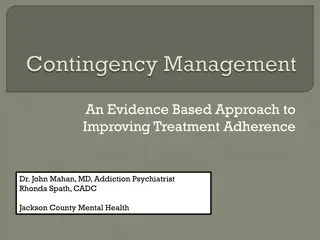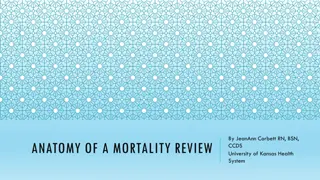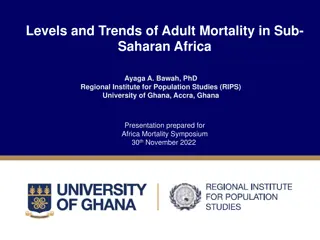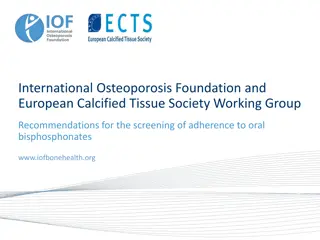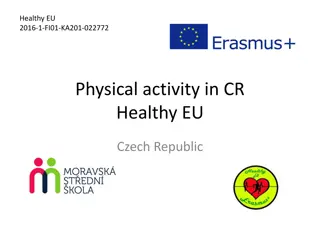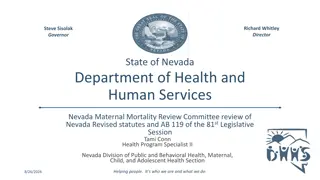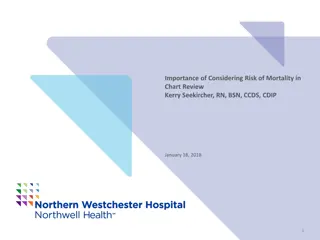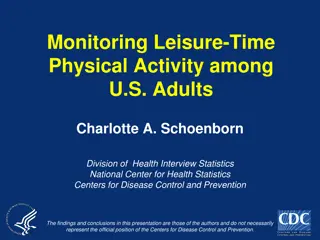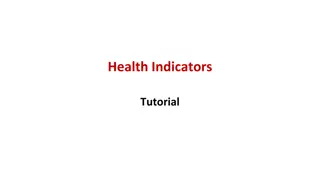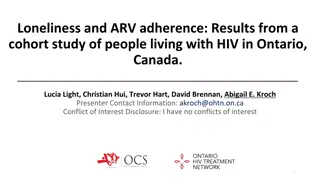Adherence to 2008 Physical Activity Guidelines & Mortality Study
This study explores the association between adherence to the 2008 Physical Activity Guidelines for Americans and all-cause mortality. It analyzes data from the NHIS and NDI to assess the risks associated with aerobic and muscle-strengthening activities. The primary objective is to evaluate mortality risks related to recommended activity levels, while the secondary objective investigates how chronic conditions impact this association. The research findings provide valuable insights into the relationship between physical activity and mortality.
Download Presentation

Please find below an Image/Link to download the presentation.
The content on the website is provided AS IS for your information and personal use only. It may not be sold, licensed, or shared on other websites without obtaining consent from the author.If you encounter any issues during the download, it is possible that the publisher has removed the file from their server.
You are allowed to download the files provided on this website for personal or commercial use, subject to the condition that they are used lawfully. All files are the property of their respective owners.
The content on the website is provided AS IS for your information and personal use only. It may not be sold, licensed, or shared on other websites without obtaining consent from the author.
E N D
Presentation Transcript
Adherence to the 2008 Physical Activity Guidelines and Mortality: Findings from Linked NHIS (1997- 2004) and NDI (1997-2006) Data Manfred Stommel, PhD, Michigan State University & 2008-2009 Academy Health Senior Service Fellow Charlotte A. Schoenborn, MPH, National Center for Health Statistics, DHIS
Context: In the fall of 2008, the U.S. Department of Health and Human Services issued the 2008 Physical Activity Guidelines for Americans. These Guidelines represented a shift away from specific frequencies and durations of vigorous and moderate activities. Instead, the 2008 Guidelines established targets for total amounts of physical activity, which could be achieved in multiple/flexible ways, with 1 minute of vigorous physical activity equating to 2 minutes of moderate activity .
Objectives: 1. The primary objective in this presentation is to assess the all-cause mortality risks associated specifically with the levels of aerobic and muscle strengthening activities recommended in the 2008 Physical Activity Guidelines for Americans for adults, using leisure-time physical activities as the measures of these activities. 2. A secondary objective is to examine how the presence or absence of chronic conditions modifies the association between meeting 2008 Guidelines recommendation and all-cause mortality.
Recommendations for Physical Activity of Adults (2008 Guidelines): Aerobic Activity: Sufficiently active : 150 minutes of moderate aerobic activity per week or 75 minutes of vigorous activity Highly active : >300 minutes of moderate aerobic activity per week or >150 minutes of vigorous activity Muscle Strengthening (in addition to Aerobics): At least 2 days of Muscle Strengthening Exercises per week involving all major muscle groups 1. 2. 3.
Data The Analytic File combines 8 years (1997- 2004) of data from the National Health Interview Survey (NHIS) and the linked mortality files of the National Death Index (NDI) containing follow-up information through 12/31/2006. 1. Information on height and weight as well as leisure-time physical activity was obtained from the NHIS Sample Adult , a sample of adult (18+) interview respondents, each of whom is randomly chosen from the adult members of a household (if more than one adult is present). 2.
Procedures for NHIS-NDI Linkage and Subsequent Analysis: 1. To be eligible for linkage between the NHIS and NDI data, a case/record had to contain one of the following combinations of identifying information: Social Security #, sex, full date of birth Last name, first initial, month of birth, year of birth Last name, first initial, Social Security # 2. Estimates for all analyses were weighted using post-stratification to adjust for missing cases due to eligibility status.
Number of Cases in Data Files Linking 1997-2004 NHIS to 1997-2006 NDI Data NHIS Respondents meeting eligibility criteria for linkage to NDI Linked NHIS Respondents who died at or before 12/31/2006 NHIS Sample Adult Respondents (Aged 18+) Year of NHIS Data Collection 1997 1998 1999 2000 2001 2002 2003 2004 Totals: 36,116 32,440 30,801 32,374 33,326 31,044 30,852 31,326 258,279 34,393 30,577 29,076 30,595 31,358 28,995 28,210 29,193 242,397 3,956 3,226 2,542 2,231 1,937 1,413 1,095 739 17,139
KEY VARIABLES 1: 1. Mortality Status (Outcome coded 1=deceased, 0=assumed alive) is based on three sources: 1. NDI Match, 2. Social Security Administration, 3. Centers for Medicare and Medicaid Services Maximum follow-up until censoring is 3639 days ( 10 years) from the NHIS interview; minimum follow-up until censoring is at least 731 days (= 2 years).
KEY VARIABLES 2: 2. Following the DHHS 2008 Physical Activity Guidelines for Americans, respondents were classified into four major groups: (1) Met neither muscle strengthening nor aerobic activity recommendation (2) Met muscle strengthening recommendations only ( 2 days per week of muscle strengthening exercise) (3) Met aerobic exercise recommendations only (leisure-time aerobic activity 150 min.) (4) Met both aerobic and muscle strengthening recommendations
KEY VARIABLES 3: 3. Alternatively, using the DHHS 2008 Physical Activity Guidelines for Americans, respondents were classified into four major aerobic exercise groups: (1) Inactive (no leisure time physical activity) (2) Somewhat active (leisure-time aerobic activity < 150 min. per week). (3) Active (leisure-time aerobic activity 150 min. per week but <300). (4) Highly active (leisure-time aerobic activity >300 min. per week). Calculations are based on self-reports of interview respondents and assume 1 minute of vigorous activity = 2 minutes of moderate physical activity
KEY VARIABLES 4: 4. Presence or Absence of at least one Chronic Health Condition Self-reported information on chronic health conditions included the presence or absence of: (1) diabetes (2) cancer (3) circulatory diseases (myocardial infarction, angina, cardiovascular diseases, and stroke), (4) respiratory diseases (emphysema, asthma, and chronic bronchitis) (5) functional limitations (any difficulty with walking, climbing steps, standing, sitting, stooping, reaching, grasping, and lifting, pushing or pulling large objects)
CONFOUNDING/CONTROL VARIABLES Age Sex Race/ethnicity (NH White, NH Black, Asian, Hispanics) Education (<HS, HS, Some Coll., B.S./B.A., Graduate Degree Poverty (<100%, 100%<200%, 200%+) Health Insurance (Medicare, Medicaid, Private, Other Government Insurance) BMI calculated from self-reported height and weight measures with a use of a correction factor (Stommel & Schoenborn, 2009) Smoking status: never smoked, former smoker, current smoker Alcohol Consumption: life-time abstainer (<12 drinks in entire life), former drinker (no drink in past year), current moderate drinker, current heavy drinker (>2 drinks per day (men) or> 1 drink per day (women) 1. 2. 3. 4. 5. 6. 7. 8. 9.
Percent of U.S. Population Meeting DHHS 2008 Physical Activity Guidelines Averaged Population Estimates for 1997-2004 3.6% 16.0% 54.0% 26.4% meets strengthening rec's only meets aerobic rec's only meets aerobic&strengthening rec's meets neither recommendations
Physically INactive U.S. Population BY Age Group and Chronic Conditions Averaged Population Estimates for 1997-2004 .8 70% percent physically inactive 61% 58% .6 55% 53% 50% 46% 46% .4 .2 0 18-34 35-49 50-64 65+ 18-34 35-49 50-64 65+ no chronic health condition 1+ chronic health condition
Physically INactive U.S. Population BY BMI Category and Chronic Conditions Averaged Population Estimates for 1997-2004 percent not physically active 80 68% 67% 62% 59% 57% 60 54% 53% 53% 49% 46% 40 20 0 obese II: 35+ obese II: 35+ obese I: 30<40 obese I: 30<40 overweight: 25<30 overweight: 25<30 underweight: <18.5 underweight: <18.5 normal weight: 18.5<25 normal weight: 18.5<25 no chronic health condition 1+ chronic health condition
Physically INactive U.S. Population BY Age Group and Sex Averaged Population Estimates for 1997-2004 .8 73% percent not physically active 61% 61% .6 56% 55% 53% 49% 39% .4 .2 0 18-34 35-49 50-64 65+ 18-34 35-49 50-64 65+ Male Female
Physically INactive U.S. Population BY Race/Ethnicity and Sex Averaged Population Estimates for 1997-2004 .8 percent not physically active 69% 69% 63% 58% .6 56% 52% 50% 47% .4 .2 0 1. NH White 1. NH White 4. Hispanic 4. Hispanic 2. NH Black 2. NH Black 3. East Asian 3. East Asian Male Female
Figure 1. Survival Probabilities by Levels of Adherence to 2008 PA Guidelines 1.00 Survival probability 0.95 0.90 0.85 0 20 40 60 80 100 120 Months from date of NHIS interview to death or censoring (December 31, 2006) Both aerobic and strengthening Aerobic only Strengthening only Met neither aerobic nor strengthening Note: U.S. adults aged 18 years and over (weighted). National Health Interview Survey (NHIS), 1997-2004
Figure 2. Survival Probabilities by Levels of Leisure-Time Aerobic Activity Only 1.00 Survival probability 0.95 0.90 0.85 0 20 40 60 80 100 120 Months from date of NHIS interview to death or censoring (December 31, 2006) > 300 minutes per week 150-300 minutes per week < 150 minutes per week No aerobic leisure-time activity Note: U.S. adults aged 18 years and over (weighted). National Health Interview Suvey (NHIS), 1997-2004
Patterns of Mortality Hazards Associated with Co-variables in Cox Proportional Hazard Models: Sex: Women have lower mortality risks: HR=0.63 Race/Ethnicity: Compared to NH Whites, mortality risk are: NH Blacks: HR=1.09, Asians: HR=0.48, Hispanics: HR=0.75 Education: Mortality hazards decline with more formal education: HR=0.76 (college graduate vs. <high school graduate)
Patterns of Mortality Hazards Associated with Co-variables in Cox Proportional Hazard Models: Poverty status: Lower Mortality Risks for Higher-Income Individuals: HR=0.83 (>200% poverty level vs. <100% poverty level) Health Insurance Status: Compared to persons without health insurance, mortality risks are as follows: Medicare HR=1.8, Medicaid: HR=1.35; Private Insurance: HR=0.94 BMI: U-shaped relationship between BMI and mortality hazard with lowest hazard at 30<BMI<32 and highest hazards at BMI<18.5
Patterns of Mortality Hazards Associated with Co-variables in Cox Proportional Hazard Models: Smoking: Compared to lifetime non-smokers, former smokers have greater mortality risks: HR=1.26, current smokers have the highest risks: HR=1.47 Consumption of alcohol: Compared to life-long abstainers, former drinkers have higher mortality risks: HR=1.1, current moderate drinkers have lowest mortality risks: HR=0.76 and current heavy drinkers have same risks: HR=1.03 *ns
All-Cause Mortality Hazards Associated with 2008 Physical Activity Guidelines Recommendations: U.S. Adults (NHIS 1997-2004 Survey Data with NDI Follow-up to 12/31/2006): Has one or more chronic health condition HR Has no chronic health condition HR 95%CI 95%CI Meets 1.00 Reference category 0.80-0.98 1.00 Reference category 0.65-1.24 neither recommendation 0.88 0.90 strength rec. only not sig. 0.53 0.49-0.55 0.76 0.69-0.84 aerobic rec. only sig. 0.42 0.38-0.47 0.58 0.49-0.68 Both recommendations sig. Cox Proportional Hazards models: Model controls for covariates: sex, race/ethnicity, education, poverty status, health insurance status, BMI, smoking, consumption of alcohol, and presence/absence of selected chronic health conditions.
All-Cause Mortality Hazards Associated with Aerobic Activity Guidelines Recommendations: U.S. Adults (NHIS 1997-2004 Survey Data with NDI Follow-up to 12/31/2006): Has one or more chronic health condition HR 1.00 Has no chronic health condition HR 1.00 95%CI Reference category 95%CI Reference category No aerobic leisure-time activity 0.67 0.63-0.71 0.78 0.68-0.89 <150 min. per week sig. 150-300 min. per week sig. >300 min. per week sig. Cox Proportional Hazards models: Model controls for covariates: sex, race/ethnicity, education, poverty status, health insurance status, BMI, smoking, consumption of alcohol, and presence/absence of selected chronic health conditions. 0.52 0.48-0.56 0.72 0.62-0.82 0.40 0.38-0.43 0.62 0.55-0.69
Discussion: Adherence to the levels of physical activity recommended in the 2008 Physical Activity Guidelines for Adults appear to have substantial survival benefits: 1.All-cause mortality risks are lower by more than 40% among persons without existing chronic co- morbidities, and by more than half among persons with chronic co-morbid conditions. 2.Even though overall mortality risks are lower among persons without chronic conditions, those with chronic conditions have more to gain from meeting the 2008 PA recommendations
Limitations: 1. The analysis as shown did not exclude persons with functional limitations. Restricting the analysis to adults who had at least one chronic condition, but no functional limitations at the time of interview, i.e., excluding cases, whose functional limitations may be the result of their closeness to death ("reverse causation"), revealed somewhat weaker hazard ratios, but adults who met the Guidelines remained at lower risk of dying than those who did not. Reliance on self-reported leisure-time physical activity may well lead to an overestimate of actual physical activity due to socially desirable responses. 2. 3.
Limitations: 4. The calculations of overall leisure-time physical activity are based on the 2008 Physical Activity Guidelines for Americans which employs a conversion factor of 1 minute of vigorous activity = 2 minutes of moderate physical activity. The ratio of vigorous to moderate physical varies systematically with (1) the BMI, and (2) age.
Relative Time Spent on Vigorous & Moderate Leisure Time Activity BY BMI Categories 10 20 30 40 50 60 70 80 90100 49 50 50 51 51 52 53 54 54 54 54 56 56 58 percent 51 50 50 49 49 48 47 46 46 46 46 44 44 42 0 <18.5 40+ 28<30 33<35 35<37 37<40 22<23.5 25<26.5 30<31.5 20.5<22 23.5<25 26.5<28 31.5<33 18.5<20.5 Vigorous Activity Moderate Activity BMI Categories
Relative Time Spent on Vigorous & Moderate Leisure Time Activity BY Age Groups 10 20 30 40 50 60 70 80 90100 45 50 53 56 62 70 percent 55 50 47 44 38 30 0 18-29 30-39 40-49 50-59 60-69 70+ Vigorous Activity Moderate Activity Age Groups

 undefined
undefined








